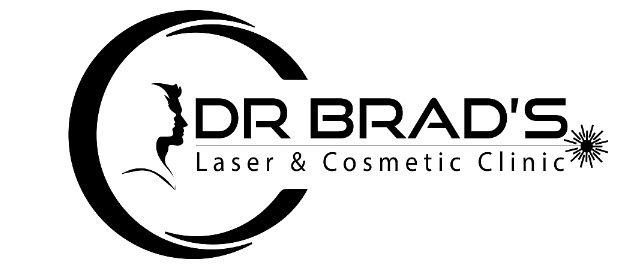Fractional laser skin treatment is one of the most high-tech and effective ways to rejuvenate the appearance of your skin.
Dr Brad is a cosmetic laser treatment doctor in Bristol who is proud to be able to offer this highly sought after laser treatment in Bristol.
Listen to what Dr Brad has to say about the Emerge laser system.
Fractional laser treatment is a great way to improve skin problems such as:
- Fine lines and wrinkles (ie crow’s feet, forehead, glabella, upper lip “smoker’s lines”, cheek lines,
- Background UV skin damage and superficial broken capillaries/minor thread veins,
- Freckles and age spots (lentigo),
- Stretch marks,
- Skin laxity/crepe,
- Rough/irregular skin texture,
- Pigmentation irregularities (dyschromia) such as “melasma”,
- Scars (not keloid-type scars though),
- Acne scarring,
- Enlarged pores (cheek/chin etc).
Pretty much any area of the skin can be treated but the most common areas to be treated include
- Face (excluding nose),
- Neck,
- Upper chest, (décolletage),
- Backs of hands,
- Abdominal stretch marks (striae gravidarum/striae distensae)
Watch Dr Brad perform an Emerge laser treatment on the crow's feet areas in the video below:
Bristol's Only Original 1410 nm Fracti0nal Laser System.
Dr Brad only offers high quality treatments so he uses the Palomar-Cynosure Emerge 1410nm fractional non-ablative laser system. Cynosure is the world's largest aesthetic laser company. Firing laser beams between just 6-20 milliseconds that are designed to penetrate well into the middle layer of your skin, the dermis, this laser is “non-ablative” which means the laser doesn’t take off or burn the outer layer of your skin because it penetrates and has it's maximal effect underneath the surface in the dermis. This means you will experience no or minimal downtime from your normal activities and people can often carry on as normal after treatment.
The laser automatically delivers a series of narrow laser beams to the skin in a grid pattern, creating little areas of tissue coagulation (heat treatment) to the middle layer of the skin. These areas are called microthermal zones or “MTZ”s. The laser intentionally leaves the majority of the skin untreated, resulting in less downtime and faster healing but still delivering great results as the coagulated areas of dermis are replaced with the all-important new collagen and elastin fibres.
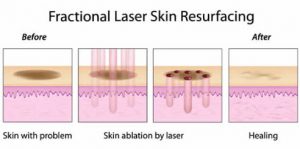
A fractional laser treats part of (a “fraction”) of the skin at a time.
At the highest setting, 70 laser beams enter a 12x8mm rectangle of your skin causing the creation of 70 MTZs, representing treatment to 2.5% of the skin. However, up to 4 passes in total may be delivered to specific problem areas, representing 280 MTZs per 12x8mm, which treats up to 10% of the skin at those areas. Even with the highest power protocol you can see that 90% of the skin at those areas is left intact so that many healthy cells are available to promote healing and reduce downtime.
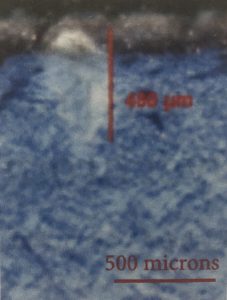
Example of a dermal microthermal zone seen under a microscope, 450 micrometers deep and 350micrometers wide.
(As an experiment, draw a 12x8mm rectangle on some paper and do 280 pencil dots on it to get an idea how much work this modern laser scanner is doing)!
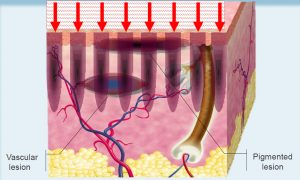
The principle of “Fractional photothermolysis” explained. Red arrows represent laser beams entering the skin creating MTZs by targeting water molecules in the upper dermis.
Laser Safety
Dr Brad is well trained in the safe and effective use of lasers and works from the fundamental first principle of Medicine which is “First, do no harm”. When you choose Dr Brad for your treatments you can be assured that you’ll be in safe hands because he can consider all aspects of your medical history, medication regime and skin history to give you the best advice. If used incorrectly, the laser can cause real and permanent harm. Amazingly, it's a recent legal anomaly that in the UK you don’t have to be medically qualified to use lasers or other powerful energy devices on members of the public! Why choose a lesser qualified person for your treatment when you can turn to Dr Brad?
As with a great painter holding a paintbrush, it's sometimes not just the tool but the person using the tool that counts when you consider the final result.
The laser is so advanced, with its “full contact sensor” technology that it simply will not activate unless the device is fully in contact with the skin. This means that you don’t strictly have to wear eye protection goggles if you're not receiving treatment to the area around the eyes.
A variety of different energy settings and protocols can be selected, to cater for different skin types and individual patient factors. Unlike some lasers, the beam targets water containing elements of the skin, (not melanin pigment), so it is comparatively safe for all skin types and races to use! Dr Brad only treats patients 18 years of age and over and as a doctor and in contrast to therapists is able to use the device “off-licence” at his discretion so can access higher power settings and deliver stronger than standard treatments if required.
Before and After Photos.
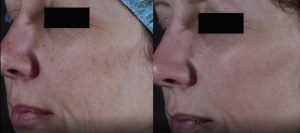
Before and 3 months after laser treatment for background UV damage and ageing.
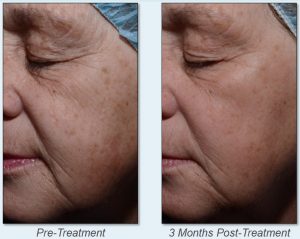
Before and 3 months laser treatment for general UV damage and ageing.
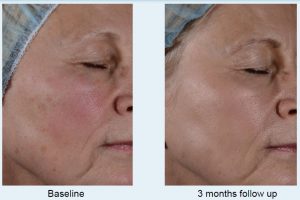
Before and 3 months after laser for age spots, wrinkles and redness.
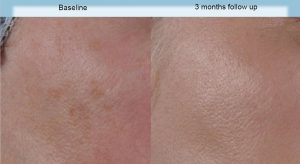
Before and 3 months after laser.
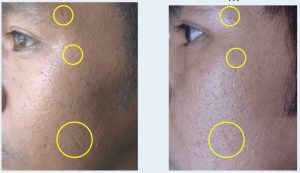
Before and 2 weeks after 3rd laser treatment for acne and pox scarring.
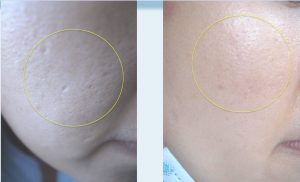
Before and 2 weeks after 3rd laser treatment for acne scarring.
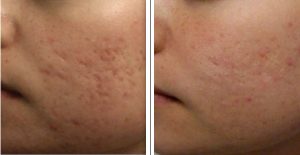
Before and 8 months after 4 laser treatments.
The Treatment Experience.
Before any laser treatment, all patients must attend a consultation with Dr Brad for discussion, examination and assessment. If Dr Brad finds that laser treatment is appropriate, you will be offered a “patch test”. This is simply an application of the laser to an innocuous area of skin ie under the chin or below/behind the ear to check that your skin responds well to the laser settings. The treated area will receive between 2-3 applications of the laser and will be approximately 2-4cm2 in size. For those with fairer skin (types 1-3) the patch may be evaluated between 3 and 7 days later. For those with darker skin (types 4-6) the patch may be evaluated between 7-14 days later.
The laser is usually tolerated very well and feels a bit tingly, perhaps sharp or warm.
To undergo this laser treatment you’ll need to make sure that your intended treatment area has not had any excessive UV sun exposure in the previous 6 weeks. You shouldn’t undergo treatment if you have a recent tan. All patients of all racial skin types should consider using a factor 30-50 sunscreen every day and avoiding excessive direct sun exposure in the 4-6 weeks preceding their treatment. No Vitamin A/retinol skin products should be used on the treatment area in the 2 weeks before treatment as it could impair the response to the treatment.
Patients with dark skin and/or patients seeking treatment for pigmentation irregularities (dyschromia) or melasma should consider using a blending/bleaching cream for up to 4 weeks before treatment, stopping 2 weeks before treatment.
On the day, you should ideally attend without make-up on the treatment area. Before treatment commences, a numbing cream can be applied if required (although most patients don’t want or need this). Dr Brad will cool the skin that is to be treated then a special gel will be applied to the treatment area to make the procedure more comfortable and effective. Dr Brad will pass the hand piece sequentially across the treatment area and you’ll hear a series of vibrations (that’s the scanner moving about inside the handpiece) followed by a ping as each laser scan is delivered. The laser emits a beautiful blue light to signal that full contact has been made. As mentioned earlier in this article, the treatment area will be scanned a minimum of two times with cooling being applied between them. Some areas will require additional laser scans for best results ie crow’s feet areas, and cooling will be applied between each one.
To give you some indication about how long a treatment session takes, a full face might take 30-45 minutes.
(There are a small number of videos of different individuals demonstrating fractional laser treatment and in many cases Dr Brad takes issue with their technique, which only goes to underline the importance of not entrusting your skin to a less qualified provider. Astonishingly, in the UK laser and IPL treatments are unregulated so any old “Tom, Dick or Harry” can set up and offer laser/IPL treatments with potentially disastrous consequences! Anyone can buy a set of fine oil paintings but not everyone can produce a Mona Lisa! Dr Brad has been rigorously examined and OFQUAL certified in Laser and Light treatments so you can be sure of the highest standards in safety and efficacy!)
After the treatment is complete, nourishing cosmeceutical products will be applied along with some sunscreen. Although sunscreen should be part of everyone’s daily skin care routine, it will be particularly important to use a physical-type sunscreen (SPF 30-50) daily for 4-6 weeks after treatment for best results and to reduce the risks of post-inflammatory hyperpigmentation (PIH).
Immediately after your treatment, there may be some redness and swelling of the face although this is usually surprisingly mild and quite quick to resolve. On close inspection of your skin you may be able to see tiny dark “pinpricks” in a grid pattern but these may not become visible for 24-48 hours. They are called micro-epidermal necrotic debris (or MENDs, for short) and simply signify the points where the laser beams entered your skin. Do not pick or rub them off as that could potentially result in a poor aesthetic result or even scarring. The presence of MEND points may cause a slightly bronzed appearance of your skin which fades as they come away naturally over 7-14 days. They are fairly difficult to see unless you are looking very closely at the area and can be easily covered with some mineral makeup if required. Skin may be a bit dry in the week after treatment so application of a good moisturizer is advised as often as required. The skin may be a bit itchy and feel a little tighter than before.
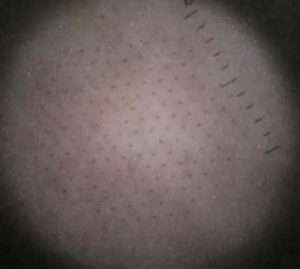
Appearance of the skin as viewed under the magnification of a dermatoscope, demonstrating the superficial MEND points.
A course of 3 sessions, performed 7-14 days apart is recommended for best results although a course of 6 may be required for more advanced problem areas.
A course of 3 treatments annually thereafter could be considered for maintenance.
Results may be tentatively assessed some 6 weeks after treatment but it's important to note that improvements can continue to be seen for 3-9 months post-treatment as the skin undergoes its slow but biologically natural re-modelling process at the cellular level.
Stretch marks often respond better to 6 sessions rather than 3, with more recent and pink stretch marks tending to respond better than older or white stretch marks. It’s possible for temporary hyper-pigmentation (up to 6 months but occasionally permanent) to occur when treating stretch marks.
After Care.
It's worth knowing how you'll have to look after yourself at home after treatment. Application of a cold pack, as required, may ease swelling, redness, itchiness or stinging. Application of an appropriate moisturiser or other recommended skin cosmeceutical to promote healing may be useful. Gentle cleansing of the skin may be performed 24 hours after treatment. Heavy makeup should be avoided for at least 24 hours. Treated areas should not be picked or scrubbed. Heavy exercise, saunas, spas and steam rooms should be avoided for 48-72 hours after treatment. For 2-6 weeks after treatment, strong direct sun exposure of the treatment area should be avoided and a high SPF sunscreen effective against UV-A and UV-B should be used daily to reduce the risks of hyperpigmentation. Daily sunscreen use should be adhered to for at least 6 months after the last treatment but is good advice for anyone anyway!
Risks and Contraindications To Treatment.
Here's the bit where we try to “scare you off”. For you to give your consent to a procedure you should be properly “informed” and able to consider risks as well as benefits.
Risks and potential side effects are as follows: oedema (swelling) and erythema (redness) both usually resolving in less than 24-48 hrs; dry skin; itching; acne flares; broken capillaries; bronzing; hyperpigmentation (darkening of the skin); hypopigmentation (lightening of the skin); scabbing; burns; bruising or blistering; infection; blanching; unsatisfactory appearance or failure to achieve the desired result.
Patients with a history of “cold sores” (AKA herpes simplex) can receive treatment but should consider taking a course of anti-viral medication around the time of treatment (prescribed by Dr Brad) to reduce the risk of an outbreak occurring after treatment.
The following is a non-exhaustive list of the most common conditions or situations that are contraindications to this laser treatment.
Medical conditions that compromise a healing response (cancer, poorly controlled diabetes etc), photosensitive epilepsy, skin cancer in the treatment area or a history of melanoma, active infections, collagen disease, autoimmune disease, immunosuppression, steroid treatment, St John’s Wort, photosensitising medication, open skin lesions, pregnancy or breast feeding (wait 6 weeks from last breast feed), bleeding disorders, keloid scarring, isotretinoin treatment in the past 6 months, use of topical Vitamin A/retinoids or exfoliating agents such as glycolic acids etc in the past 2 weeks, no tanning should be done in the past 4 weeks and not done for 4-6 weeks after treatment, fake tan, heat urticaria, dermal fillers/implants (depending on the person/treatment), toxinjectables within the past 2 weeks.
Pricing.
Consultation and initial test patching £60
Choose from 3 treatment areas: Face, Neck, Upper Chest (Decolletage).
Full Face:
£297 for one session
Course of 3 treatments: £825
Partial Face Treatment (one of crow's feet/upper lip/cheeks/forehead)
£125 for 1 session
£330 for 3 sessions
– – –
Special Carboxytherapy Upgrade Offer For Laser Treatments.
Emerge laser patients qualify for 10% off any carboxytherapy treatment package. Carboxytherapy can be delivered immediately after your laser treatment and once or twice a week thereafter for an enhanced experience.
Calecim Professional Serum Upgrade
Add Calecim Profession Serum after each treatment to promote skin healing and reduce downtime for just £75 a time.
Calecim Professional Multi-Action Cream Aftercare
Care for your skin between treatments with Calecim Professional Multi-Action Cream for just £165.
In Conclusion.
The 1410nm fractional non-ablative laser is a safe and effective device for the treatment of a wide range of cosmetic skin problems related to the ageing process including crepiness, wrinkles and brown age-spots.
Laser treatment is a powerful, cutting edge stand alone treatment but for even better treatment outcomes you could consider combining it with other treatments.
Dr Brad offers his treatments and expertise at very competitive prices and with his patient’s very best interests at heart. Book for your consultation and test patch today and see the benefits for yourself!
